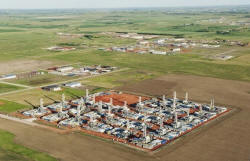|
Oil prices dip, rising
U.S. output offsets OPEC cuts
 Send a link to a friend
Send a link to a friend
 [February 28, 2017]
By Sabina Zawadzki [February 28, 2017]
By Sabina Zawadzki
LONDON
(Reuters) - Global oil prices dipped on Tuesday but continued to trade
in a tight range with the OPEC-led output cuts offset by increasing
crude production from the United States.
The Organization of the Petroleum Exporting Countries has so far
surprised the market by showing record compliance with oil-output curbs,
and could improve in coming months as the biggest laggards - the United
Arab Emirates and Iraq - pledge to catch up quickly with their targets.
But while the Nov. 30 agreement to reduce production prompted oil prices
to rise $10 a barrel, they have been trading in a narrow $3 range in
recent weeks.
Benchmarks Brent and West Texas Intermediate crude oil on Tuesday traded
several cents on either side of the previous day's close. By 1130 GMT,
Brent was 16 cents lower at $55.77 a barrel while the U.S. benchmark was
9 cents lower at $53.96.
"Oil is well and truly stuck and the falling futures volumes does not
indicate that we have much of a bull-bear fight either," Saxo Bank head
of commodity strategy Ole Hansen said.

"Having failed on a couple of occasions to break higher it is only
natural to see it correct lower. I'm looking for a retracement to $55 on
Brent and $52.70 on WTI."
OPEC agreed to curb output by about 1.2 million barrels per day (bpd)
from Jan. 1, the first cut in eight years.
In addition, 11 non-OPEC oil producers have promised to cut their output
- Russia reduced production by 124,000 barrels per day this month
compared with October levels, Interfax reported on Tuesday citing a
source familiar with the data.
Several analysts noted record high bets on rising Brent and WTI prices,
as showed by data from the InterContinental Exchange and the U.S.
Commodity Futures Trading Commission (CFTC).
[to top of second column] |

Stacked rigs are seen along with other idled oil drilling equipment
at a depot in Dickinson, North Dakota June 26, 2015. REUTERS/Andrew
Cullen/File Photo

"Increasingly, the high degree of speculative interest is hanging over oil
prices like the sword of Damocles. If financial investors were to unwind their
positions, a sharp fall in prices would be on the cards," Commerzbank said in a
note to clients.
Broadly, analysts and economists expect an average 2017 Brent price of 57.52 a
barrel, according to a Reuters poll issued on Tuesday.
Oil industry and OPEC country sources told Reuters Saudi Arabia wanted crude
prices to rise to $60 a barrel this year, a level it saw as encouraging
investments but not spurring a fresh surge in U.S. shale production.
But a report from consultancy Rystad Energy issued earlier this month said the
break-even price for U.S. shale oil producers fell last year to an average $35
per barrel.
U.S. producers boosted crude production to over 9 million bpd during the week
ended Feb. 17 for the first time since April 2016, according to federal data.
U.S. drillers were operating 602 rigs last week, the most since October 2015,
energy services firm Baker Hughes said on Friday.
(Additional reporting by Naveen Thukral in Singapore, editing by Louise Heavens
and David Evans)
[© 2017 Thomson Reuters. All rights
reserved.] Copyright 2017 Reuters. All rights reserved. This material may not be published,
broadcast, rewritten or redistributed.
 |